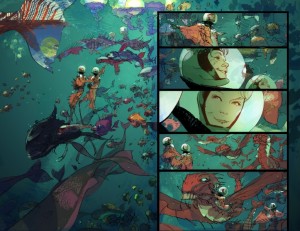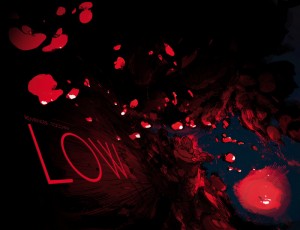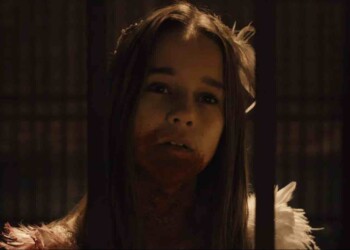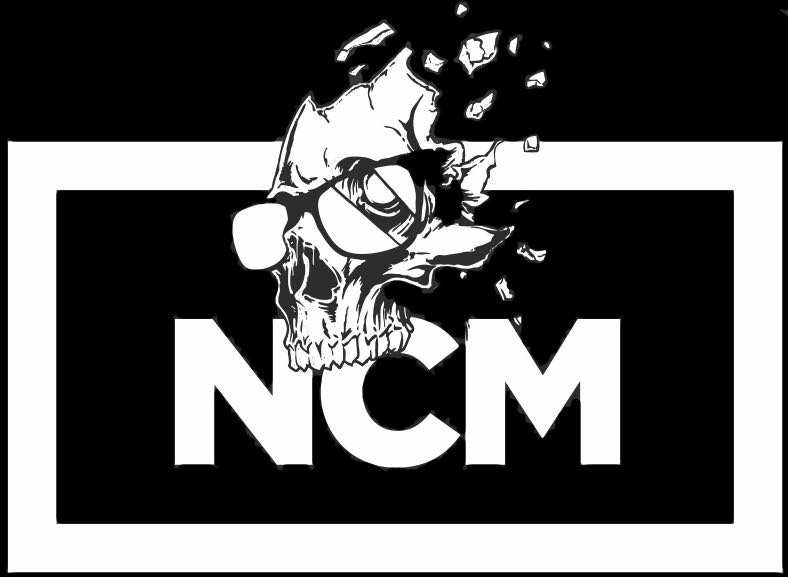As a society, our pop culture pallets have evolved in such a way that bleak and downtrodden stories taste decadent. Our shows. Our movies. Our books. Our personal fantasies. All are covered with the crawling moss of the post-apocalyptic. An overwhelming number of our stories take place in worlds where either our careless natures have left us struggling through our own wake, or where we, as humans, are made helpless by some great, uncontrollable catastrophe, reduced as a whole to nothing but a collection of helpless victims.
The Walking Dead, Falling Skies, Fallout, The Road, The Stand, and zombie tale, upon zombie tale, upon zombie tale. We devour these stories where dour, tortured heroes are redeemed, either because they save a loved one by being better at violence than other survivors, or by retrieving a magical hope allegory that puts the world right again.
When you begin reading Low, these tropes blaze like road flares.
The surface of earth has been made unlivable, so man has spent the last few millennia festering in underwater cities. Now, after breathing the same recycled air for generations, the supply has become toxic. Within a year, the last remaining city will be unable to supply breathable air to its people.
This impending doom is not a secret to the remaining people of earth. As issue #3 opens, the ruling class of the last human city partake in a room-spanning orgy. They gorge themselves on euphoria inducing narcotics and pontificate about mankind’s passing. If they are going to die, they are going to party to the last minute.
The art lays this scene out in a double-paged spread. The line work is soft and flowing and everything takes place in an arena of red and orange blankets. This gives the whole scene the warm, calm feel of a sunset. The soft colors and the resigned, accepting mood of the drug-satisfied aristocrats gives the reader a view that mankind has accepted its fate and is ready to walk quietly into the darkness.
It’s a different kind of hopelessness than what is normally shown to us in these stories. Rather than burned out cityscapes or the sad skeletons of familiar landmarks, this post-apocalyptic world feeds us our bleakness with caricatures of a broken human spirit.
The vehicle that brings us to this scene is one of our two main characters: Stal. She has come to the orgy looking for a senator.
At the end of the previous issue, Stal received a signal from a space probe that returned to earth after generations of exploring space in hopes of finding a new planet capable of supporting human life.
The probe has crashed on the surface of the planet, a place no one has gone in thousands of years, and Stal needs the senator’s help to retrieve it.
The senator’s nihilism, and drug and orgasm-induced apathy makes the request almost fruitless, but Stal is eventually granted transport and resources for her and one other person; her adult son, Marik.
Marik is a drug-addicted and disgraced peace keeper, and is the overt avatar of post-apocalyptic hopelessness in the story. When the reader first sees him in this issue, he sits alone in his prison cell, tying a noose and taking inventory of his many failures – collecting evidence to justify his own deservedness of death. Stal stops his suicide attempt and takes him, against his will, on a journey to save humanity.
Trapped in a sub together and floating up towards a burned-down world, Low sheds its triteness and descends to a place of ugly hopefulness that inspires its reader, while dissecting the post-apocalyptic mindset.
From the beginning of the series, Stal has been a character malignant with hope. She has lost her husband and daughters. She watches humanity shrivel and die. She watches her son turn from a great scientific mind into a violent, drug-addicted monster. But she, herself, is never defeated. She never loses hope that there might still be a way to give humans a second chance.
Post-apocalyptic stories use hope as an endgame; a goal in order to recover or rebuild something lost. Here it is not only never lost, it is catalytic. It is refreshing to see such a depressingly rendered futurescape through a relentlessly hopeful filter. Until you read this issue, you don’t realize how serious and melancholy this genre is usually portrayed. The contrast provided by Stal’s positive outlook is jarring at moments.
Too much of her might actually have given the reader an ice cream headache of sorts – too much sweetness too fast – but she is balanced by Marik’s complete defeat.
They argue the practicality of optimism as they pilot a single-room sub to the surface. Both hope and nihilism are embodied and forced to face each other with no escape, and it is an absolute joy to watch. Should humanity fight to the end when, odds are, they are wasting their last bits of life on a empty venture? Or should they pass away in peace? Moving to the next life on their own terms.
The events of their ascension complement their arguments as the situation ping-pongs from disaster to serendipity, at times proving each characters’ view.
The whole scene is marvelous, well thought out, and might be one of the most layered scenes you will find in any comic this year.
Low is still in its infancy as a series, but in the closing panels of this week’s issue we see it wink at what it might become: An allegory of the ongoing fight to see a bleak world as one filled with light. Still, this is not a series that pushes the idea that positivity is the solution to everything. It acknowledges the more valid argument of pessimism. It asks the reader to hold on to hope, but admits that hope might not always be the answer.
Low has a refreshing and pragmatic view of looking at life, and it’s an even more refreshing reminder that post-apocalyptic fiction can escape its clichés and become something more complex. The ideas in Low are still just seeds, and the story is not even out of its first arc, but you will have a hard time finding a book out there with as much potential as this one.








